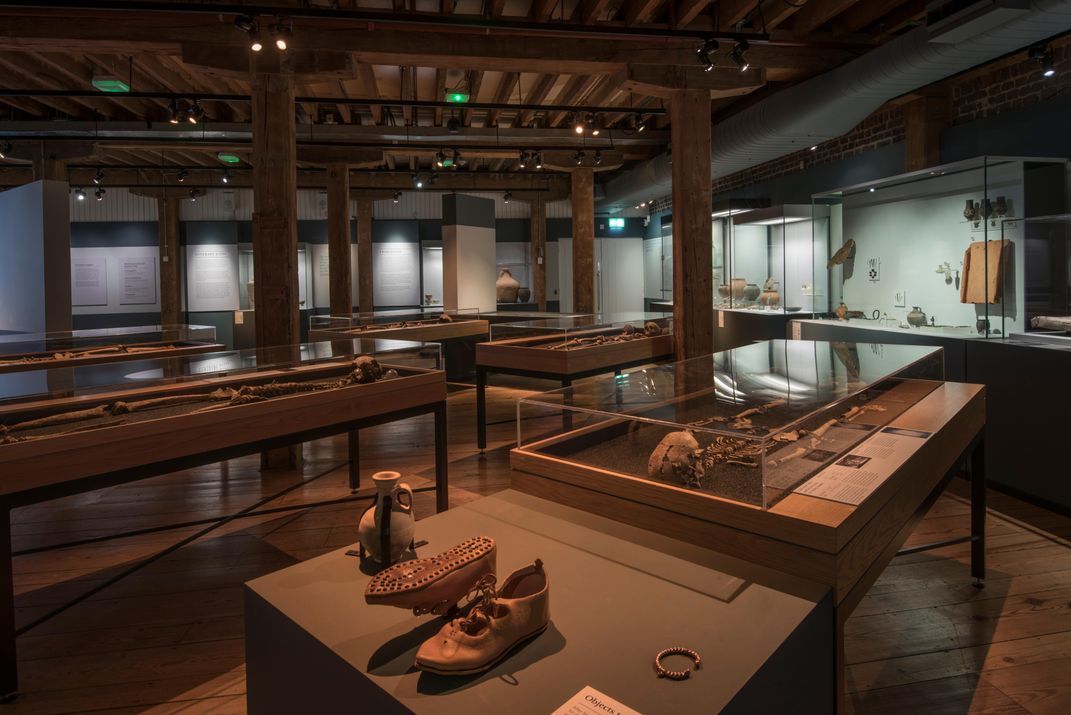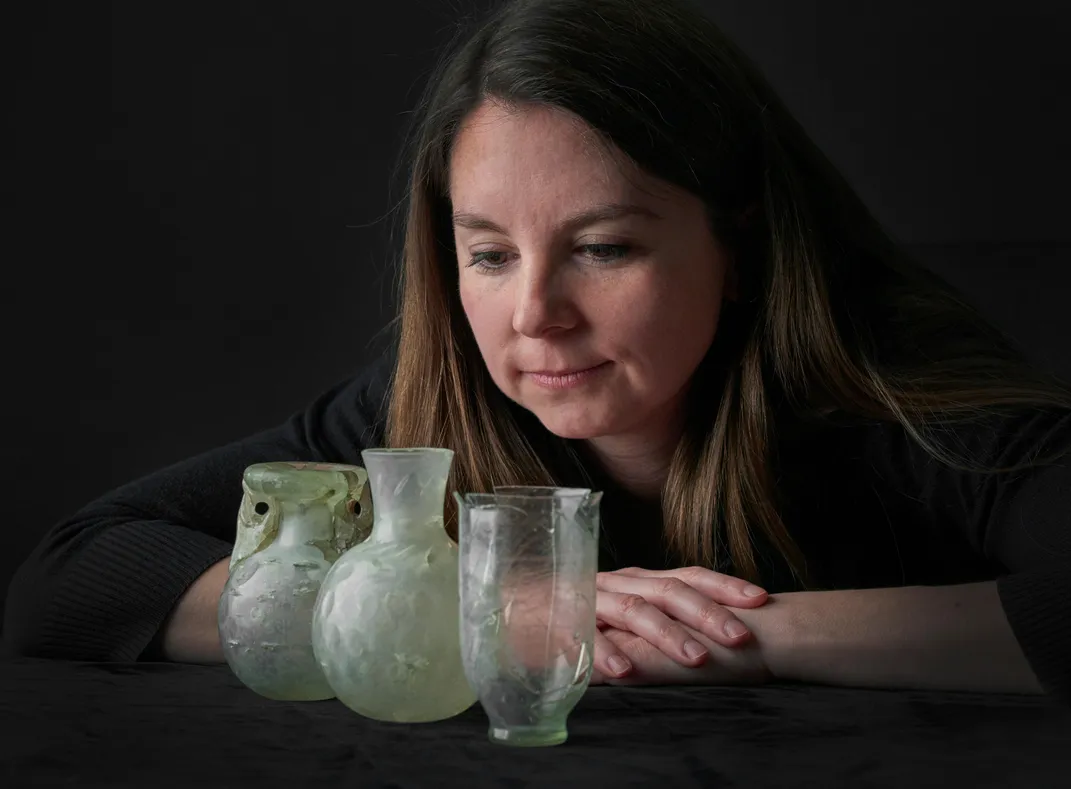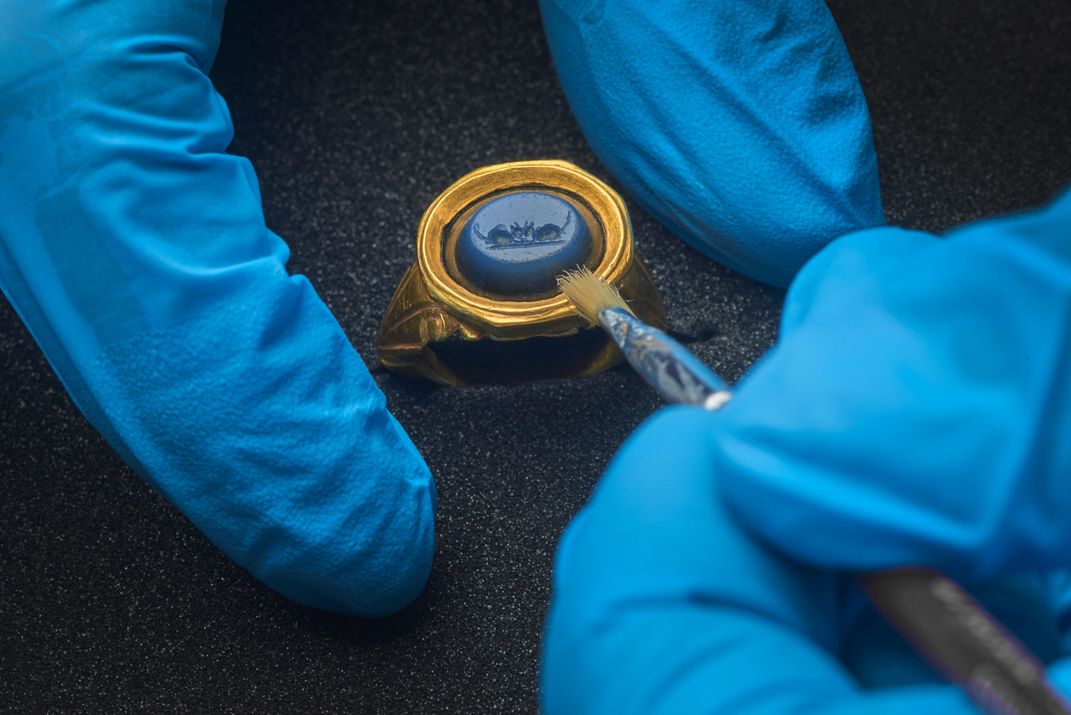The Dead Beneath London’s Streets
Human remains dating back to the Roman Empire populate the grounds below the surface, representing a burden for developers but a boon for archaeologists
/https://tf-cmsv2-smithsonianmag-media.s3.amazonaws.com/filer/6b/69/6b69d2a5-e86e-4540-9cd3-2164ac97c102/four_to_five_skulls_of_men_showing_signs_of_violent_death__museum_of_london.jpg)
Grave robbers had gotten there first. Sometime in the 16th century, they ransacked the tomb for its gold and grave goods, leaving the bones behind and lid cracked.
But five centuries later, on the southern banks of the Thames, in London’s Southwark neighborhood, the Roman sarcophagus was unearthed again, this time by construction workers building a new residential development. Weighing nearly three tons and buried sometime between 86 and 328 A.D., the stone sarcophagus contained the body of a woman believed to have been about 30 years old at the time of her death. The bones of an infant were found with her, but it’s unclear whether the woman and child were buried together.
The sarcophagus dates to London’s earliest years, not long after the Romans planted the walled settlement of Londinium on the marshy north bank of the Thames in 43A.D. The sarcophagus, to the south of the settlement and across the river, was found just to the west of a Roman road, covered by centuries of human construction and detritus.
It was the find of a lifetime for the archaeologists who worked on it. But in the course of London’s nearly 2,000-year history, perhaps it’s not so surprising at all.
The sarcophagus, its occupants, and 40 years’ worth of London’s Roman burial finds are part of an exhibition at the Museum of London Docklands running until the end of October. “Roman Dead”, inspired by the sarcophagus’s discovery, explores how Roman Londoners treated death; many of the objects have never before been displayed. Some of the finds are grim, even for skeletons: four of the skulls on display came from a pit found near the London Wall (the Roman-built wall that once encircled the city) filled with more than 40 skulls of men between the ages of 18 and 35, all killed by blunt force trauma to the head.
Others are mysterious: the skeleton of a dog, buried in her own grave with her collar but without her head; an iron ring welded in place around an arm, unclear whether it was done before or after death or why. The exhibition also seeks to show that London has been, from its founding, a center of trade, peopled by immigrants from across the known world. One of the skeletons, for example, belonged to a blue-eyed woman of black African ancestry who travelled to London via southern Mediterranean trade routes. She was just one of the nearly 60,000 residents the settlement boasted at the height of Rome’s power in Britannia.

The exhibition underscores one of the most important and consistent sources of archaeological information under London’s streets: the bones. And there are a lot of bones. Though the population of Londinium declined after the Romans left in the fifth century, the city trundled on for two centuries more. Its fortunes changed with the renewed attention of the Saxons, who called it Lundenwic, and over the next millennia, it continued to attract people, power and trade.
During the medieval period, people were buried in churchyards, of which there were more than 100 in the City of London. When the population was only around 15,000, as it was in 1100, burying people in the churchyard was sustainable. When it rose to 80,000 by the end of the 13th century, it became less so. And when people died in unimaginable numbers, as they did in during the plague years – in 1348, the Black Death killed around 40,000 people within months – parish cemeteries became dangerously crowded. The response was mass burial grounds in fields outside the city walls, but the city soon swallowed these, too.
This history of London, punctuated by the ebb and flow of populations, means that the physical remains of countless Londoners sit just there, under the pavements. Glittering Terminal Five at Heathrow Airport? Construction uncovered fragments of a Neolithic monument, bronze spearheads, a Roman lead font, an early Saxon settlement, and medieval coins, evidence of 9,000 years of near-continuous human habitation. Just feet from the MI6 building – the one blown up in Skyfall – archaeologists discovered the oldest structure in London: 6,000-year-old Mesolithic timber piles stuck deep in the Thames foreshore, the remains of a structure that once sat at the mouths of the Thames and the River Effra. In the basement of Bloomberg’s new European headquarters in the heart of the City, there’s a modern shrine honoring an ancient temple, the Roman Mithraeum, built in 240 A.D. next to the river Walbrook to honor the Roman god Mithras. In the basement of a high-end hair salon in Leadenhall, just past the rows of chairs and mirrors, are the remnants of a Roman wall.
London is a city built on bones, both figuratively and very literally. Luckily for archaeologists, the United Kingdom is one of few European countries that actively asks developers to balance the needs of the present against the preservation of the past.
***
In the 1570s, the City of London was one square mile of squalor and wonder. Behind walls plotted by the Romans and defended by the Saxons, London’s 180,000 inhabitants breathed, ate, slept, defecated and died in a space denser than the most crowded cities of today.
This was a London that needed somewhere to put all of these people. New buildings were going up where they could, made from timber, brick and stone “recycled” from existing structures (including any remaining Roman walls or ruins that hadn’t been picked over before). Clay for bricks could be dug from pits outside the walls and in 1576, a group of workmen were doing just that in an area of fields and orchards just beyond Bishopsgate, called Spitalfields. As they trawled through the deep earth with shovels and picks, separating the rocks from the clay, they made a discovery.
“Many earthen pots, called Vrnae, were found full of Ashes, and burnt bones of men, to wit, of the Romanes that inhabited here,” writes John Stow in his 1598 Survay of London: Contayning the Originall, Antiquity, Increase, Modern estate and description of that cities. Stow, a Bishopsgate tailor-turned-documentarian of the life of the city, was there in the clay pit that day. He saw the urns, each containing the burnt bones and ashes of dead Romans and “one peece of Copper mony, with the inscription of the Emperour then raigning”. He saw “vials and other fashioned Glasses, some most cunningly wrought, such as I have not seene the like, and some of Christall, all which had water in them, nothing differing in clearnes, taste, or savour from common spring water, what so ever it was at the first: some of these Glasses had Oyle in them verie thicke, and earthie in savour, some were supposed to have balme in them, but had lost the virtue.” He saw smooth red earthenware dishes, with Roman letters stamped on the bottoms, and lamps decorated with Roman figures.
And, of course, he saw bones. He’d heard reports of stone sarcophagi – just like the one found in Southwark – being dug up in the same field, and saw for himself the bones of people who’d been buried in timber coffins, the wood long since disintegrated, leaving only the long iron nails behind. The other men on the site, he said, declared that “the men there buried were murdered by drilling those nayles into their heads,” but he reasoned that explanation “unlikely” – the nails, he said, still had fragments of wood under their heads. He took home one of the nails, as well as the man’s lower jaw, “the teeth being great, sound, and fixed”. He also held onto an urn, with its bones and ashes, and a small pot in the shape of a hare squatting on her hind legs.
Stow’s account demonstrates what makes London London: The past can’t stay buried in a city that’s always digging it up. It’s only been in the last century, though, that real effort has gone into preserving that past. Stow’s Spitalfields Roman burial site was uncovered at a time when, while there might have been a reverence for ancient remains and the stories they told, there was no mechanism for removing and investigating them. What was removed – human and material remains – ended up in private collections or, quite possibly, the rubbish.
“There wasn’t such a feeling of, ‘Ooh, we must preserve this,’” says Meriel Jeater, curator of the Museum of London’s archaeology collection. “Later on, in the 17th century, during the rebuilding of London after the Great Fire, other Roman remains were found and they were recorded by antiquaries and kept in people’s collections… Christopher Wren [St. Paul’s architect] found Roman remains during the reconstruction of St. Paul’s Cathedral, and a Roman tombstone was found near Ludgate, people were very excited at the time.” But they didn’t really know what to do with what they found.

In the 18th and 19th centuries, as cabinets of curiosities gave way to museums and interest in classical antiquity reached a peak inspired by the Romantic movement, academics turned their attention to these finds. But even through the Victorian Era and into the 20th century, though there may have been a popular interest in antiquities this was not enough to motivate some property developers to preserve what they might have found in the course of building. Moreover, explains Jeater, the Victorians preserved only what they valued: coffins, urns, and sarcophagi, yes; the bones within them, no.
Despite the modern instinct to preserve sites untouched, many artifacts wouldn’t have been found at all if it hadn’t been for the perpetual need to redevelop and to build in a city that can’t stop growing. During Stow’s lifetime, the population of London quadrupled, reaching 250,000 in 1600, one-eighth of the entire population of England. By the time of the Georgians, areas that had once been suburbs of the City were now more or less central and increasingly crowded. With the Industrial Revolution in full swing, the population of the city exploded from 630,000 in the 1700s to 2.32 million people in 1850, making London the largest city in the world. By then, it was nearly 17 miles from end to end, straddling the great river and swallowing up whole villages, but in just the last 100 years, London continued to grow, increasing its population by more than 60 percent. This churn of development makes the job of an archeologist in the city even trickier: “You might have a Roman layer, and bits of medieval dug down into that, then there’s post-medieval and modern things going in, too,” says Jeater.
In the middle of the 20th century, the city’s building boom wasn’t only the result of growth—one-in-six London buildings were destroyed during the Blitz in World War II. In the years after the bombings, archaeologists – now more alive than ever to the need to preserve history – scrambled to excavate sites before developers built over them. “It was a really challenging environment,” says Jeater, who in 2017 curated an exhibition of photographs of this period of London archaeology for the Museum. One early archaeologist, Ivor Noel Hume, who later went on to manage the excavation of Colonial Williamsburg, “nearly got wiped out by a crane once.”
But those excavations were done on an ad hoc basis. “They were only there due to the goodwill of people doing the construction,” says Jeater. That generosity only stretched as far as was useful for developers: the foundations of Bloomberg’s Mithraeum were actually found in 1954, during the post-war rebuilding of an office block, but developers simply noted the find and then dismantled it, removing it from its original site and for a short time, displaying it on the roof of a parking garage.
By 1989, historians and archaeologists had had enough. The discovery of the foundations of Shakespeare’s Rose Theatre on the southern bank of the Thames prompted nationwide protest when it appeared that developers would be razing the grounds. Ultimately, the building was redesigned to accommodate the foundations, but in response to the outcry, Parliament passed legislation the following year requiring developers to plan to manage a site’s history before obtaining permission; if a developer is unable to preserve finds in situ, which is preferred, there must be a plan to preserve them in record or offsite. But, crucially, developers are required to pay for everything, from the site assessments to the excavation itself; most estimates put planning for archaeology at 1 to 3 percent of the development’s total budget. By 2007, 93 percent of all archaeology in the United Kingdom was being paid for by developers.
“Archaeology is completely intertwined in the planning process. From a very early point in the project, time has been already allocated for it,” says Marit Leenstra, an archaeologist with the Museum of London Archaeology (MOLA), a charitable organization that conducts archaeological excavations on behalf of developers in and around London (it is no longer affiliated with the Museum of London). In some cases, developers will decide to make their development’s unique archaeological history part of the building. When Bloomberg bought the site of the Mithraeum in 2010, the company decided to reunite the temple with its original location, turn it into a museum space, and employed MOLA to excavate further.
This expectation was part of the reason that excavation of the Southwark site, where the Roman sarcophagus was discovered, went so smoothly. It’s also why further excavation of Spitalfieds, where John Stow made off with a human jawbone, was able to recover another Roman sarcophagus, as well as the remains of 126 people, dozens of homes from Stow’s own time, and an 18th-century umbrella manufacturing factory.

It’s a process that has worked for more than 25 years and, said Leenstra, has been an inspiration for other European countries, including France, which passed similar “preventative archaeology” legislation in 2001. “I think the rest of Europe is catching up,” she says. Meanwhile, this formal acknowledgement of the importance of preserving the country’s deep history has opened new realms of possibility for research in the city. “It’s about recording as much as you can in that area before it changes, and it’s about opportunity – we wouldn’t be able to dig in the center of London unless a new office building was being built,” explains Jeater.
*********
Now, all bones, no matter how small and fragmented, are logged into a database maintained by the Centre for Human Bioarchaeology, part of the Museum of London. By 2014, the database had recorded bones from 16,207 individual skeletons, spanning nearly the entirety of documented human habitation in the London area. And those are just the ones they’ve found.
So are the chances good that even now, when you’re walking the streets of London or wandering through one of its parks, you’re probably walking over someone’s grave? “Oh, yes,” says Jeater.
Modern archaeology in London demonstrates that the past and the present are never far from each other. And that they need each other – without the need to constantly reinvent this ancient city, archaeologists would never get the chance to see what (or who) is under those office blocks and terraced houses. This has always been the case for a city like London; it’s only now, however, that the need to build is tempered by the inclination to preserve.
/https://tf-cmsv2-smithsonianmag-media.s3.amazonaws.com/accounts/headshot/LindaRodriguezMcRobbieLandscape.jpg.jpeg)
/https://tf-cmsv2-smithsonianmag-media.s3.amazonaws.com/accounts/headshot/LindaRodriguezMcRobbieLandscape.jpg.jpeg)